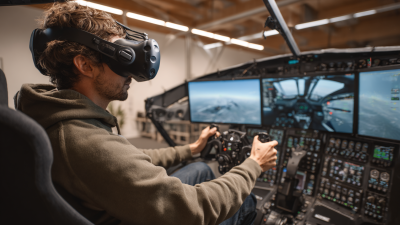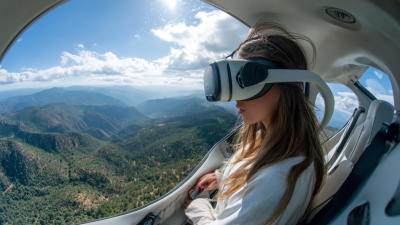Innovative Trends in VR Flying Simulator Technology at the 138th Canton Fair 2025
Table of Contents
- Emerging Innovations in VR Flying Simulators Showcased at the Canton Fair
- Integrating AI for Enhanced Realism in Flight Simulation Experiences
- Exploring User-Centric Design Trends in VR Flying Simulators
- The Impact of 5G Technology on VR Flight Simulation Performance
- Future Applications of VR Flying Simulators Beyond Gaming Industries
- Collaboration Opportunities between Tech Companies and Flight Training Institutions
- FAQS
- Conclusion
- Related Posts
The 138th Canton Fair in 2025 showcases the
latest advancements in virtual reality,
particularly in VR flying simulator technology,
a segment experiencing exponential growth. According to a report by the International Data Corporation (IDC),
the global virtual reality market is projected to reach $57.55 billion by 2027,
with VR flying simulators playing a crucial role in this expansion.
 Guangzhou Longcheng Electronic Co., Ltd., operating under the brand VART VR,
stands at the forefront of this innovative technology. As one of the earliest VR simulator manufacturers in China,
VART VR is dedicated to delivering high-quality VR solutions,
leveraging its extensive experience and a skilled workforce of over 60 professionals across an
8000 square meter facility.
This event not only highlights the transformative potential of VR flying simulators
but also underscores the commitment of companies like VART VR to
revolutionize the way consumers engage with virtual environments.
Guangzhou Longcheng Electronic Co., Ltd., operating under the brand VART VR,
stands at the forefront of this innovative technology. As one of the earliest VR simulator manufacturers in China,
VART VR is dedicated to delivering high-quality VR solutions,
leveraging its extensive experience and a skilled workforce of over 60 professionals across an
8000 square meter facility.
This event not only highlights the transformative potential of VR flying simulators
but also underscores the commitment of companies like VART VR to
revolutionize the way consumers engage with virtual environments.
Emerging Innovations in VR Flying Simulators Showcased at the Canton Fair
At the 138th Canton Fair in 2025, emerging innovations in VR flying simulators are capturing the attention of industry experts and enthusiasts alike. These state-of-the-art simulators represent a significant leap forward in virtual reality technology, offering users immersive and lifelike flying experiences. The advancements showcased at the fair emphasize enhanced realism, with improved graphics, physics simulations, and user interactivity, making them ideal for both entertainment and training purposes.
Guangzhou Longcheng Electronic Co., Ltd., known as VART VR, is at the forefront of this technological evolution. As one of the earliest VR simulator manufacturers in China, the company has developed a comprehensive range of VR solutions within its 8000 square meter facility. With a dedicated team of over 60 professionals, VART VR offers innovative flying simulators that align perfectly with the latest trends presented at the Canton Fair. Their commitment to providing one-stop VR project solutions positions them as a key player in the evolving landscape of virtual reality technology, ensuring users experience unparalleled adventures in the sky.
Integrating AI for Enhanced Realism in Flight Simulation Experiences
At the 138th Canton Fair 2025, the spotlight is on the cutting-edge advancements in VR flying simulator technology, particularly the integration of artificial intelligence (AI) to create more immersive flight experiences. Recent industry reports indicate that the global flight simulator market is projected to reach $9.07 billion by 2027, growing at a CAGR of 4.41% from 2020 (ResearchAndMarkets, 2020). This growth is fueled in large part by AI applications that enhance realism, allowing users to engage in virtual flying experiences that closely mimic real-world conditions.

One of the most promising trends observed at the fair is the incorporation of machine learning algorithms that adapt to user behavior, enabling personalized simulation experiences. AI-powered systems can analyze data from flight patterns and pilot responses in real-time, adjusting scenarios to improve learning outcomes and user engagement. For instance, simulating emergencies and dynamic weather changes based on actual flight data helps users experience authentic challenges they would face in real flying scenarios.
Tips for making the most of your VR flying simulator experience include regularly practicing with different aircraft models to understand their unique flight dynamics and utilizing the AI features for tailored training sessions. Additionally, consider collaborating with other users to share insights and experiences, as this can significantly enhance your learning process. The continued evolution of VR and AI technology promises to transform the way aspiring pilots and aviation enthusiasts experience flight simulation.
Exploring User-Centric Design Trends in VR Flying Simulators
At the 138th Canton Fair in 2025, the spotlight shines on the latest advancements in VR flying simulator technology, with a keen focus on user-centric design trends. The evolution of these simulators illustrates a commitment to enhancing user experience through immersive and intuitive interfaces. By incorporating feedback from diverse user groups, developers are refining graphical fidelity and interaction mechanics, making simulations feel more authentic and accessible to novices and seasoned enthusiasts alike.
One of the prominent trends observed is the integration of customizable features, enabling users to tailor their flying experience. This includes adjustable control settings, personalized flight environments, and adaptive difficulty levels that cater to individual skill levels. Furthermore, the incorporation of haptic feedback systems allows users to physically feel the nuances of flight, enhancing realism and engagement. Overall, these user-driven innovations are setting new standards in VR technology, ensuring that flying simulators not only captivate users but also empower them to engage in their learning and exploration journey.
The Impact of 5G Technology on VR Flight Simulation Performance
The advent of 5G technology is poised to revolutionize the VR flight simulation industry, especially as showcased at the 138th Canton Fair in 2025. With its unprecedented data transfer speeds, low latency, and enhanced connectivity, 5G significantly enhances the realism and responsiveness of VR flying simulators. According to a report by MarketsandMarkets, the global VR market is expected to grow from $15.81 billion in 2020 to $57.55 billion by 2027, driven in part by breakthroughs in telecommunications technology like 5G.
In practical terms, the impact of 5G on VR flight simulations is substantial. The lower latency—potentially as low as 1 millisecond—allows for real-time updates and interactions, making simulations more immersive. A study by Ericsson predicts that user experience will improve by over 30% in VR applications utilizing 5G networks compared to their 4G predecessors. This level of performance not only enhances training for pilots but also opens up new avenues for recreational users and gaming enthusiasts, ultimately fostering broader acceptance and innovation in the VR flight simulation market.

Future Applications of VR Flying Simulators Beyond Gaming Industries
The VR flying simulator market is witnessing transformative innovations, expanding far beyond traditional gaming applications. According to industry reports, the global flight simulator market is projected to reach approximately $6 billion by 2027, driven by advancements in technology and increasing demand across various sectors. Notably, the aerospace and defense industries are leveraging VR simulators for enhanced training programs, allowing pilots to simulate complex scenarios without the risks associated with real flights.
Moreover, the automotive sector is integrating VR flying simulators for testing and research and development, as the technology provides a low-risk environment to assess vehicle dynamics and aerodynamics. With VR applications also emerging in the media and entertainment industries, immersive experiences are being crafted that blend flying simulation with storytelling, creating new avenues for engagement.
Tip: Companies exploring VR applications should focus on building partnerships with educational institutions to develop comprehensive training programs using these simulators, as this synergy could vastly enhance workforce readiness in critical industries. Additionally, keeping an eye on emerging trends within the industry can provide businesses with insights to stay competitive.
Collaboration Opportunities between Tech Companies and Flight Training Institutions
The 138th Canton Fair in 2025 presents a unique opportunity for collaboration between technology companies and flight training institutions, especially in the evolving field of VR flying simulator technology. With leading aerospace companies driving innovation and a heightened interest in advanced flight training solutions, this partnership could enhance the educational landscape for aspiring pilots. For instance, the recent introduction of AI-driven training tools showcases a commitment to improving simulator experiences, which could be significantly bolstered by VR technology.
Tips: When considering collaboration, institutions should emphasize the integration of cutting-edge technology like VR within their curriculums. Following trends in aviation-related partnerships can also lead to successful funding opportunities and improved student engagement, thus fostering a more immersive learning environment.
As flight training organizations continue to experiment with innovative training methods, alliances with tech companies can facilitate the development of tailored VR simulators. Partnerships can allow training bodies to leverage advanced software to replicate various flying conditions and scenarios. This not only enhances pilot preparedness but also ensures training is safe, efficient, and engaging.
Innovative Trends in VR Flying Simulator Technology
This chart displays the growing adoption rates of VR flying simulator technology across different flight training institutions from 2021 to 2025. As the technology evolves, collaboration opportunities between tech companies and these institutions are expected to increase significantly.
FAQS
: The VR flying simulators feature enhanced realism, improved graphics, physics simulations, and increased user interactivity, making them suitable for both entertainment and training.
Guangzhou Longcheng Electronic Co., Ltd., known as VART VR, is at the forefront of the VR flying simulator innovation, with a dedicated team and a comprehensive range of VR solutions.
5G technology has improved data transfer speeds, reduced latency, and enhanced connectivity, resulting in more realistic and responsive VR flight simulations.
The global VR market is projected to grow from $15.81 billion in 2020 to $57.55 billion by 2027, fueled in part by advancements in telecommunications like 5G.
Lower latency, as low as 1 millisecond, enables real-time updates and interactions in VR applications, improving user experience by over 30% compared to 4G networks.
The advanced technology and realism provided by VR flying simulators enhance the training experience for pilots, allowing for more effective simulation of flying conditions.
Yes, the advancements in VR flight simulations not only benefit pilots in training but also open new avenues for recreational users and gaming enthusiasts.
VART VR operates out of an 8000 square meter facility dedicated to developing innovative VR solutions.
VART VR specializes in providing one-stop VR project solutions, focusing on innovations in flying simulators and enhancing user experience.
A study predicts that user experience will improve by over 30% in VR applications using 5G compared to those using 4G technology.
Conclusion
The 138th Canton Fair in 2025 showcased groundbreaking advancements in VR flying simulator technology, reflecting the industry's rapid evolution. Innovations included the integration of artificial intelligence to enhance realism in flight simulation experiences, making them more immersive and lifelike. User-centric design trends emerged, focusing on improving accessibility and engagement for a broader audience. The impact of 5G technology was also a focal point, significantly boosting performance and connectivity for VR flying simulators.
Additionally, the fair highlighted the potential applications of VR flying simulators beyond the gaming industry, such as in flight training and educational environments. Collaboration opportunities between tech companies and flight training institutions were discussed, emphasizing the importance of partnerships in advancing simulation technology. As a pioneer VR simulator manufacturer, Guangzhou Longcheng Electronic Co., Ltd. VART VR is well-positioned to leverage these innovations and contribute to the evolving landscape of VR flying simulators.
Related Posts
-

5 Tips for Mastering Your Experience with Vr Flying Simulator
-

How to Choose the Best VR Flight Games for an Immersive Experience
-

How to Choose the Perfect VR Motorbike Simulator for Your Business Needs
-

How to Enhance Your Movie Experience Using Vr Mall Cinema Technology
-

Innovative Solutions for Enhancing VR Experience with the Next Generation VR Chair 360
-

How to Elevate Your Business with Vr Flight Solutions

